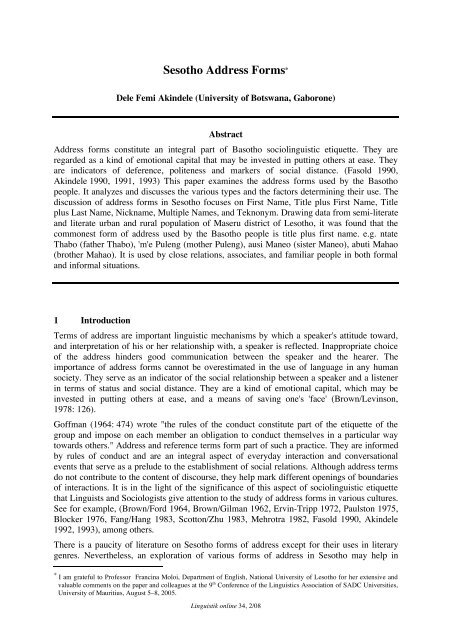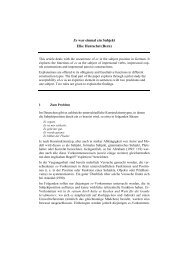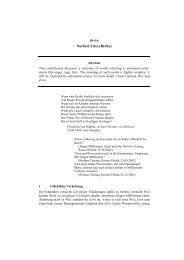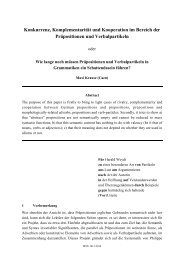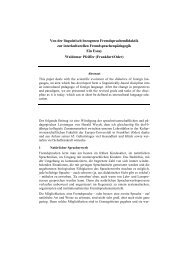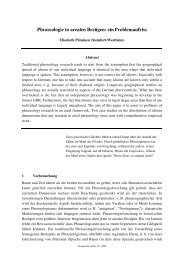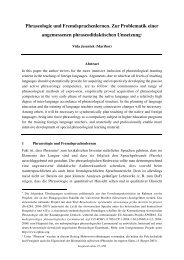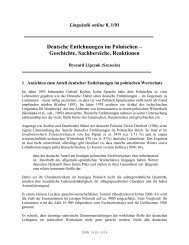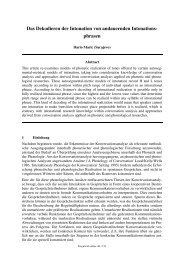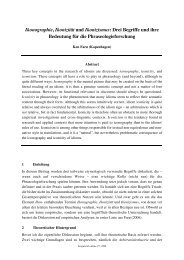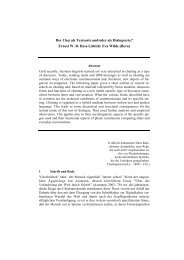Sesotho Adress Forms - Linguistik online
Sesotho Adress Forms - Linguistik online
Sesotho Adress Forms - Linguistik online
- No tags were found...
Create successful ePaper yourself
Turn your PDF publications into a flip-book with our unique Google optimized e-Paper software.
<strong>Sesotho</strong> Address <strong>Forms</strong> *Dele Femi Akindele (University of Botswana, Gaborone)AbstractAddress forms constitute an integral part of Basotho sociolinguistic etiquette. They areregarded as a kind of emotional capital that may be invested in putting others at ease. Theyare indicators of deference, politeness and markers of social distance. (Fasold 1990,Akindele 1990, 1991, 1993) This paper examines the address forms used by the Basothopeople. It analyzes and discusses the various types and the factors determining their use. Thediscussion of address forms in <strong>Sesotho</strong> focuses on First Name, Title plus First Name, Titleplus Last Name, Nickname, Multiple Names, and Teknonym. Drawing data from semi-literateand literate urban and rural population of Maseru district of Lesotho, it was found that thecommonest form of address used by the Basotho people is title plus first name. e.g. ntateThabo (father Thabo), 'm'e Puleng (mother Puleng), ausi Maneo (sister Maneo), abuti Mahao(brother Mahao). It is used by close relations, associates, and familiar people in both formaland informal situations.1 IntroductionTerms of address are important linguistic mechanisms by which a speaker's attitude toward,and interpretation of his or her relationship with, a speaker is reflected. Inappropriate choiceof the address hinders good communication between the speaker and the hearer. Theimportance of address forms cannot be overestimated in the use of language in any humansociety. They serve as an indicator of the social relationship between a speaker and a listenerin terms of status and social distance. They are a kind of emotional capital, which may beinvested in putting others at ease, and a means of saving one's 'face' (Brown/Levinson,1978: 126).Goffman (1964: 474) wrote "the rules of the conduct constitute part of the etiquette of thegroup and impose on each member an obligation to conduct themselves in a particular waytowards others." Address and reference terms form part of such a practice. They are informedby rules of conduct and are an integral aspect of everyday interaction and conversationalevents that serve as a prelude to the establishment of social relations. Although address termsdo not contribute to the content of discourse, they help mark different openings of boundariesof interactions. It is in the light of the significance of this aspect of sociolinguistic etiquettethat Linguists and Sociologists give attention to the study of address forms in various cultures.See for example, (Brown/Ford 1964, Brown/Gilman 1962, Ervin-Tripp 1972, Paulston 1975,Blocker 1976, Fang/Hang 1983, Scotton/Zhu 1983, Mehrotra 1982, Fasold 1990, Akindele1992, 1993), among others.There is a paucity of literature on <strong>Sesotho</strong> forms of address except for their uses in literarygenres. Nevertheless, an exploration of various forms of address in <strong>Sesotho</strong> may help in* I am grateful to Professor Francina Moloi, Department of English, National University of Lesotho for her extensive andvaluable comments on the paper and colleagues at the 9 th Conference of the Linguistics Association of SADC Universities,University of Mauritius, August 5–8, 2005.<strong>Linguistik</strong> <strong>online</strong> 34, 2/08
Dele Femi Akindele: <strong>Sesotho</strong> Address <strong>Forms</strong>590). Typically, teknonym is used in informal contexts by spouses who prefer it to FN as anaddress term if they have children (Salami 2004). Married couples prefer addressing eachother with teknonyms rather than FN.Brown/Ford (1961) discovered in their study of American address form, the use of MultipleNames (MN) such as Brian James Trennepohl. This occurs when people who have becomeclose friends find out that the exclusive use of mutual FN, Brian, for example, no longerseems enough to symbolize friendship. In this case, they will address each other with MN.That is, they will sometimes use TLN, Mr. Trennepohl; sometimes FN (Brian) or LN(Trennepohl) or a nickname (NN), Bobby (Brown/Ford 1961: 450). These address forms arenot used to express anger: they are used in more or less free variation; and the person whouses MN need not be reciprocal.Leeds-Hurwitz (1980) study also highlights the use of MN. She reports how a woman whohad just been promoted to a somewhat ambiguous position in a business concern used nonreciprocalMN to help her carve out her place in the institutional hierarchy. The use of MNform of address is discernible in Yoruba in modern times. For instance, some of my closefriends sometimes address me as Femi (FN), Dr. Akindele (TLN) and at times Akindele (LN).When they do so, such address terms are not used to express anger; rather it is believed that itis done out of intimacy and mutual relationship. Such address terms are very often nonreciprocal.Ervin-Tripp (1972) in her research on address terms based on American academic communitylocated in the West observes that speakers who are on reasonably close terms with theaddressee use some form of TLN. This agrees with Brown/Ford's (1964) and Fasold's (1990)observations of the use of address terms in American English. This is also observable inYoruba use of address term e.g. Ogbeni Taiwo (Mr Taiwo).One other form of address term found in American English is a nickname. That is, name usedinformally instead of one's own name. This is usually given because of one's character or as ashort form of the actual name. It is said to be a non-reciprocal form of address. Such anaddress form is found in Yoruba use of address, for instance; Femi (Olufemi). The onlysituation where the use of nickname is non-reciprocal in Yoruba is when one of the parties tothe interaction has none.Fasold (1990: 78) observes that in American English the use of Last Name (LN) alone is ingeneral rare and that it is common only in certain occupation groups and normally amongpeople of the same sex. He adds that FN + LN is seldom or never used except by angryparents in giving orders to children. This seems to be the case among the Yoruba use ofaddress forms of this type. For instance, a mother could call her child to order by merelyshouting e.g. Olufemi Akindele. On the other hand, an intimate friend could address the otherone with FN + LN on certain occasions, say, for instance, meeting one another after severalmonths or years, e.g. Laolu Ayodele, Iyabo Adewale.Fasold (1990: 78) also suggests that a lay - person is more likely to be addressed by FN than areligious person, or a casual friend than a less intimate acquaintance person of the same sexthan one of the opposite sex. The suggestion holds for Yoruba as well; but is not the case forthe Basotho. Although there seems to be considerable agreement on what characteristics leadto FN, TLN and MN usage; there is a considerable individual variation about what combinationof these characteristics represent enough solidarity to justify using each of the terms.From the available literature on the form and uses of address in Yoruba, there is evidence thatvery little or nothing significant has been done in the area. There are, however, all types of theuses of address forms that can be inferred from Yoruba literary genres. These genres do notspecifically focus on address forms but could be seen as indicating their uses particularlyISSN 1615-3014
6<strong>Linguistik</strong> <strong>online</strong> 34, 2/08when characters in such texts address one another and at different occasions. Some of thestudies on Yoruba address forms are Soyoye (1984) and Akindele (1991, 1992).Soyoye (1984) concluded a study of the nominal terms of address in Standard Yoruba andStandard French. He observes that it is not normal to address someone with TLN in StandardYoruba. The normal occurrence is to address people by Title (T) only (p. 31). Such titlesinclude: occupational titles e.g. Oluwa mi – (my lord) for a judge, dokita – medical doctor,Omowe – Ph.D. holder, Ojogbon – Professor, Olootu – editor, Ogagun – top army officer;Chieftancy titles e.g. Oloye – chief, Oba, kabiyesi – king etc.; religious titles e.g. Alufa –Pastor, Eniowo – Reverend.Soyoye (1984: 29f.) also observes that members of the Yoruba family, their friends andneighbours older than the speaker receive dad or mum. Those that are not old enough arenormally addressed as brother, sister, aunt. He points out that wives address theirbrother/sister-in-law (whether older or younger), brother, uncle, sister, aunt e.g. brother Femi,Sister Peju, Uncle Dele, Aunty Toyin. This practice is very current. It is as a result of culturalcontact with the Europeans, which led to language change. Traditionally, wives are normallyaddressed by nicknames which were derived from physical attributes of the personsconcerned e.g. agba owu – plumpy/fat girl/woman; akuruyejo – short beautiful lady;adumaradan – dark beautiful lady; ibadi aran – a lady with prominent buttocks.Akindele (1991, 1992) studies on Yoruba address forms observe among others, predominantuse of tiles (T) such as Omowe (Doctor), Alhaji (Mecca Pilgrim), Oluko (teacher); as well asthe use of teknonymy such as mama Janet (mother Janet – Janet's mother), baba Dele (fatherDele – Dele's father). The studies concluded that the Yoruba are fond of titles to the extentthat they could be annoyed when they are not addressed with their appropriate titles; andthose without titles preferred to be addressed with TKM. It was also concluded that theYoruba do not favour the use of first names (FN) except among students and modern-daywestern educated people.In a related study on Yoruba address forms, Salami (2004) focuses on the usage of first names(FN), teknonyms (TKM) and pet names (PN) by Yoruba-speaking women in addressing andreferring to their husbands. The study demonstrates how language use helps to carry andreinforce gender relations; and examines the influence of the changing social structure such asthe variables of education, age and region of origin on Yoruba women's use of address formswith their spouses.It focuses on such questions as how a woman would address her husband (1) when togetheralone (2) when in the presence of husband's parents, (3) when in the presence of children and(4) during courtship. Salami (2004:2) shows that the use of first names, teknonyms and petnames or terms of endearment as address forms by Yoruba women in relation to their spousesis not only variable but that the patterns of use can be structured according to the women'sage, educational attainment and region of origin within the Yoruba-speaking South-westernNigeria. In FN usage, the study demonstrates also that changes in the role-relationshipsbetween a Yoruba man and his wife, from a fiancée to a wife and also as mother, have asignificant impact on Yoruba women and their use of address terms. Furthermore, the papershows that although in traditional Yoruba society wives do not address their husbands by firstnames in the presence of their parents-in-law and children, younger women and postsecondaryeducated women are, today, motivating changes in the use of address terms byYoruba women (Salami 2004: 9).Afful (2007: 3) studied address terms usage among university students in Ghana. Using anethnographic-style design, he examines the use of four descriptive phrases such as denotativelyand culturally pejorative: Kwasea Boy ('stupid boy'), Naughty Boy and Foolish Man asaddress terms by students in a Ghanaian public university (Afful 2007: 5). Analysis of theseISSN 1615-3014
Dele Femi Akindele: <strong>Sesotho</strong> Address <strong>Forms</strong>7address terms indicate that these address terms were conditioned by context of situation andsocio-cultural indices such as solidarity, gender, age as well as pragmatic factors. Thefindings suggest that the descriptive phrase (DP) provides a description of a person to enablehim/her to know that s/he is being addressed; that is, it functions principally as an attentiongetter and identifier. In most cases, when addressers are not known by their names but oughtto be distinguished from others around, DPs are used. The most interesting group of DPs,Kwasea Boy tended to be used reciprocally among male students of either the same or similarage. Its English equivalents, Naughty Boy and Foolish Boy/Man, were used in a similar vein(Afful 2007: 8).3 Theoretical Background3.1 Definition of terms: Basotho and <strong>Sesotho</strong>Perhaps it may be necessary to define the terms <strong>Sesotho</strong> and Basotho as used in this studybefore proceeding to discuss the methodology employed. Lesotho is a landlocked countryentirely surrounded by the Republic of South Africa and has a population of about 2 millionpeople. The people are referred to as Basotho (pl.) and Mosotho (sg). The Basotho peopleemerged from the accomplished diplomacy of Moshoeshoe I who brought together and unitedclans of Sotho-Tswana origin that had dispersed across southern Africa in the early nineteenthcentury. They were largely Bantu-speaking ethnic groups during Bantu migrations. Today,they live mostly in Lesotho in the ten administrative districts namely Maseru, Berea, MohalesHoek, Quithing, Qacha's Nek, Leribe, Butha Buthe, Mafeteng, Mohotlong, Thaba Tseka andin the Republic of South Africa.The language spoken is <strong>Sesotho</strong>. <strong>Sesotho</strong> is a Bantu language, belonging to the Niger-Congolanguage family. It is most closely related to three other major languages in the Sotho-Tswanalanguage group: Setswana (spoken in Botswana), the Northern Sotho languages (spoken inSouth Africa) and Silozi (spoken in Zambia). <strong>Sesotho</strong> is, and has always been, the name of thelanguage itself, and this term has come into wider use in South Africa and in Lesotho. <strong>Sesotho</strong>is also sometimes referred to as Southern Sotho, principally to distinguish it from NorthernSotho, the South African variety.In Lesotho, <strong>Sesotho</strong> is the national and one of the two official languages, English being thesecond one. <strong>Sesotho</strong> is spoken by all the Basotho regardless of the different ethnic groups towhich they belong. That is why it is always said that Lesotho is "one nation, one language".(Mokitimi 1997: xviii). Nevertheless, there are several people of Nguni origin who speak theirown language in their districts, such as Setaung, Setebele, Sephuthi, (Akindele 2002: 64). Theterm Basotho is used in this study to mean "<strong>Sesotho</strong> speakers," and "residents of Lesotho".Thus, all minor ethnic groups living in Lesotho such as speakers of Nguni languagesSephuthi, Setebele and Setaung, which have been heavily influenced by <strong>Sesotho</strong> areconsidered to be <strong>Sesotho</strong> speakers.3.2 MethodologyResearchers in the area of address terms have employed various methods of collecting data.Some have used native speaker introspection and others have used personal observationscross-checked to a greater extent by native-speakers (Akindele 1991). The present studyentails another approach namely collection of data by means of questionnaire and introspectionby native speakers from within their own circle of friends and relations in both urban andperi-urban Maseru, the capital of Lesotho. Forty-five third year students taking my DiscourseAnalysis course in 2001/2002 at the National University of Lesotho assisted in collecting thevarious forms of <strong>Sesotho</strong> address terms from their friends and relations by means of audio-ISSN 1615-3014
8<strong>Linguistik</strong> <strong>online</strong> 34, 2/08recording. The recordings involved 200 people drawn from urban and rural Maseru district ofLesotho. The students who also used participant observation, made notes of people's addressbehaviour. These involved adults, male/female of differing ages in various places: shoppingcentres, offices, on the streets, village gatherings, families, and funerals. The audio-recordedaddress forms were jointly transcribed by the researcher and some of the students-reporters.The transcriptions were then cross-checked with other <strong>Sesotho</strong> speakers who were academiccolleagues in the university. The advantage of this method is that data passes through twostages of introspection by native speakers i.e. the informants and student reporters.Secondly, questionnaires were also administered on selected 200 Basotho drawn from thesame set of 250 people whose interactions were earlier on recorded in the urban and ruralMaseru district on how they address people in formal and informal settings. The questionnairewhich was administered by some of my Basotho students includes forms of address used ininteractions such as: Friend/friend, close relations, subordinates/boss, boss/subordinates,boss/boss, co-workers, schoolmate/teachers, schools mates/school mates, among others.Also, factors determining the choice of address terms were asked. Some of these factors aredictated by the context of the situation. These factors were obtained from the responses tosome of the questionnaires administered. The average age of the subjects was 25 to 50 years.The participants were literate and semi literate male and female. In the population studied,100 were male and 100 female. In the group, 120 were married while 80 were single.The following questions were asked the subjects about the use of <strong>Sesotho</strong> address terms:1. How do you address your friends/relations at work?, with FN, TKM, TFN, NN, TLN?2. How do you address them outside the workplace?, with FN, TKM, TFN, NN, TLN?3. Do you address persons who have no children with TKM, TFN, NN, FN, TLN?4. Do you address those with children with TKM, TFN, TLN, NN, FN?5. How do you address those in 3 when you talk about them to others?6. How do you refer to those in 4 when you talk about them to others?4 Analysis of <strong>Sesotho</strong> address forms<strong>Sesotho</strong> address forms uses are determined by such factors as location, status, age and sex. Ofall these, age seemed to be an overriding factor in the use of address terms among theBasotho. The observations made by the students who collected the data for the study revealsthat the Basotho use the following forms of address:1. Title (T) only: Moruti (pastor/priest), ntate (father), monghali (Mr), Mm'e (mother),mofumahali (Mrs/madam), matsamaisi (master), mofumahatsana (Miss), abuti (olderbrother), ausi (older sister), moruti (pastor/reverend), morena (Chief), moholo(superior/elder brother/elder of the church), Mmangwane (maternal aunt), rakgali(paternal aunt), malome (maternal uncle), rangwane (paternal uncle).2. Title with first name (TFN): 'Mm'e Pulane, Mm'e Palesa, Ntate Raphael, Mm'e Maneo,Mm'e Mpho.3. Title with last name (TLN): Ntate Marumo, Ntate Tsikoane, Mm'e Motsamai, Mm'eLikoti, Moruti Mokhathi (Pastor Mokhathi), Ntate Mokoena.4. First names: Thato, Karabo, Palesa, Seabata, Shale, Mothusi, Pulane/Puleng.5. Nicknames: Sido for Mosito, Itu/Ido for Itumeleng.6. Multiple names: Maneo Mpho Maphisa, Lineo Lerato Ntsike.ISSN 1615-3014
Dele Femi Akindele: <strong>Sesotho</strong> Address <strong>Forms</strong>97. Teknonyms: Mathato (mother of Thato), Mampho (mother of Mpho), Ntat'alimpho(father of Limpho, Mmapapa (mother who sells food – papa).In <strong>Sesotho</strong>, address terms derived from titles are of different kinds. There are those that arederived from professions e.g. sistere (nun/sister), mookamedi (headmaster), moruti (pastor/priest). Others are derived from chieftaincy e.g. morena (chief); and still many others arederived from kinship terms e.g. moholo (superior/elder brother/elder of the church),Mmangwane (maternal aunt), Rakgali (paternal aunt), Malome (maternal uncle), Rangwane(paternal uncle), Ntate (father), Monghali (Mr), Mm'e (mother), Mofumahali (Mrs/madam),Matsamaisi (Master), Mofumahatsana (Miss), abuti (brother), ausi (sister).As indicated above, teknonymy is a form of address derived from a combination of the nameof the child and its father or mother (F/M + PN = TKM). These are: Mmathato (mother ofThato), Mmampho (mother of Mpho, Ntat'alimpho (father of Limpho, Mmapapa (mother whosells food – papa). In <strong>Sesotho</strong>, teknonyms have attained the status of real names particularlyfor women. It is often found that some women particularly those with children are addressedas Mmasechaba, Mmamuso, Mmampho, and thsese have become their real names among theBasotho after their prolonged use. Teknonymy can thus be defined as the practice amongcertain peoples of Africa of renaming a parent after a child. A teknonym is therefore a nameor an address term that is a combination of a parent's name and the name of his/her child, andwhich in most cases has attained the status of proper names, such as Mmalerato, Ntatalimpho.Three types of teknonyms are discernible in <strong>Sesotho</strong> address forms. They are derived from thefollowing combinations: the name of the child plus mother/father (N + M/F), kinship termplus business (KT + B); a child's profession plus father/mother (CN + F/M). The firstcategory involves naming the father/mother after the child's personal name and addressing theman/woman as such. This is quite common among the Basotho. Thus, one hears veryfrequently such names or address terms as illustrated above. This type of term of address isused for married couples with children.The second type of teknonym is derived from a combination of kinship terms and the businessof the person involved, as in: Mmapapa (mother who sells mealie meal papa). The thirdcategory of teknonym involves the addition of the names of the profession of the child(ren)plus father/mother, as in the following examples: matichere (mother of teacher), ntat'amoruti(father of priest/reverend father).The use of teknonym was noted to be more common among women than men in Lesotho.This compares favourably with its use among the Yoruba of Nigeria, the Swazis of Swazilandand the Batswana of Botswana among others. It was observed that there is considerablevariation in the use of first name, title with first name, title with last name and multiplenames, as outlined sequentially below:– FN is common among school peers.– TFN/TLN among adults.– TKM used at work and outside work place by familiar people.– TFN is the commonest <strong>Sesotho</strong> form of address.It was also observed that there were differences in the use of address forms in the urban areasand in the villages. This could be a consequence of acculturation in the urban setting e.g.Tichere (teacher), Sistere (sister).Address terms are used as a marker of social status among the Basotho. For instance, a specialtitle other than Ntate (Mr) or 'Mm'e (Mrs/Miss), can be used to distinguish gender. In formalsituations, Monghali (Mr), Mofumahali (Mrs), Mofumahatsana (Miss) and MohlankanaISSN 1615-3014
10<strong>Linguistik</strong> <strong>online</strong> 34, 2/08(youngman, boy, Master of ceremonies) are used respectively to differentiate betweenmarried men and women and unmarried girls and boys.Brown/Ford (1961) observe that in American English, if people are very angry with someonethey usually address with FN, they might withdraw to TLN to symbolise the disruption of therelationship. When the issue that caused trouble is resolved, they return to FN, for example:How are you, James (FN)?; I'm well, Mr Carter (TLN). This is not so with the Basotho. Itwas observed by my informants that when a speaker has begun using FN in Basotho address,he/she might use TLN again with the same addressee even when there is no quarrel betweenthem. There were instances when intimate friends who used to address each other with FNused TLN or teknonym as a mark of deference in a given social context. For instance, at theworkers meeting which involved the junior workers complaining about the conditions of theirwork place, the following discourse took place between close friends before thecommencement of the meeting:A: Ho Joang 'Mm'e Mmaitumeleng?How is it Itumeleng's mother (TKN)B: Ho monate 'Mm'e Mmat'sepo.It's fine T'sepo's mother (TKN)And during the meeting, the following encounter ensued between the two participants:A: Mookameli oa ka, ke kopa u fane ka maikutlo.My superior, please give your opinion.B: E a monate...Thanks...Ervin-Tripp (1969: 230) remarks that a priest, physician, dentist, or judge may be addressedby title alone, but a plain citizen may not. In these cases, if the name is unknown, the onlyoption of address form that is available is sir and ma'am. The following serves to illustrate thepoint. Note that the parentheses refer to optional elements, the bracketed elements are socialselection categories.[Cardinal]: Your excellency[US President]: Mr President[Priest]:Father (+ LN)[Nun]:Sister (+ religious name)[Physician]: Doctor (+ LN)[Ph.D., Ed.D.] etc.: Doctor (+ LN)[Professor]: Professor (+ LN)[Adult] etc.: (Mister + LN), (Mrs + LN), (Miss + LN)Similar address forms are found in <strong>Sesotho</strong> address and are used in similar ways, though therecould be variations, depending on the context of situation, as indicated above.With respect to social class differences in the use of address terms, Ervin-Tripp (1969)remarks that members of lower-status occupational groups often use titles such as Doctorwithout last name as address forms. Similar use of address is found in <strong>Sesotho</strong> address formbut also TLN is used quite often, as in Ntate Morolong.Another form of address rules has to do with the way Americans address strangers in publicsituations. Where male or female's name is unknown, it is common to use the respect formma'am or sir respectively. Terms of endearment such as dear or hon are used quite frequentlyto address women and sir to address men. In <strong>Sesotho</strong> address forms, women are addressed asISSN 1615-3014
Dele Femi Akindele: <strong>Sesotho</strong> Address <strong>Forms</strong>11'mm'e and men as ntate. There could be a variation if the relationship between the twointerractants is known e.g. moholo (superior/elder brother/elder of the church, malome(maternal uncle), magwane (maternal aunt), ranwane (paternal uncle), abuti (elder brother),ausi (elder sister).5 Data analysisIn what follows, an analysis of the data collected with the aid of questionnaire is undertaken.This is followed by a discussion of the findings. The baseline used in calculating thepercentage scores for each questionnaire is 200. For instance, if a total number of 150 subjectsrespond positively to the use of TFN, that means that it is 150 out of 200 people thatresponded. The percentage of this figure is therefore 75%. The following tables summarisethe various responses to the questionnaire.5.1 FindingsParticipantsFNNo. %TKMNo. %TLNNo. %NNNo. %TFNNo. %Gross Total %200 people 30 15 50 25 60 30 5 2.5 55 27.5 100100 males 5 2.5 10 5 50 25 5 2.5 30 15 50100 females 5 2.5 45 22.5 25 12.5 5 2.5 20 10 50Table 1: Responses to questionnaire 1:How do you address your friends/relations at work? With FN, TKM, TFN, NN, TLN?The findings in Table 1 show that out of the 200 people interviewed on how they wouldaddress people at work, 25% said they would employ Teknonym, 30% use title + last name,15% use first name, while 2.5% said they would address such people with nickname and27.5% will address people with TFN. The table further suggests that 5% of the males useTKM while only 22.5% of females use it. 25% of the male interviewees use TLN while12.5% of the females do; and for FN 2.5% males and 2.5% females use it respectively. 2.5%males and 2.5% females said they use nicknames to address people at work. 15% male saidthey use TFN and 10% female use this form of address.ParticipantsFNNo. %TKMNo. %TLNNo. %NNNo. %TFNNo. %Gross Total %200 people 10 5 50 25 60 30 10 5 70 35 100100 males 5 2.5 5 2.5 35 17.5 5 2.5 40 20 50100 females 5 2.5 35 17.5 20 10 5 2.5 35 17.5 50Table 2: Responses to questionnaire 2:How do you address them outside the workplace? With FN, TKM, TFN, NN, TLN?Table 2 contains the findings on the use of address forms outside the workplace. The tableindicates that 25% subjects claimed that they use TKM; out of these, 2.5% were males and17.5% were females. 30% of those interviewed also said they use TLN. This is made up of17.5% males and 10% females. Only5% of the subjects use FN made up of 2.5% males and2.5% females. 2.5% male use NN and 2.5% female said they use NN, and this includes 8.35%males and 8.35 females respectively. In all 35% use TFN made up of 25% male and 15%female.ISSN 1615-3014
12<strong>Linguistik</strong> <strong>online</strong> 34, 2/08ParticipantsFNNo. %TKMNo. %TLNNo. %NNNo. %TFNNo. %Gross Total %200 people 10 5 90 45 40 20 0 0 55 27.5 100100 males 5 2.5 15 7.5 30 15 0 0 50 25 50100 females 5 2.5 40 20 30 17.5 0 0 25 12.5 50Table 3: Responses to questionnaire 3:Do you address persons who have no children with TKM, TFN, NN, FN, TLN?Table 3 summarizes the findings on how interviewees address persons with children in faceto-faceinteraction. The table indicates that 45% of the subjects employ TKM and this is madeup of 7.5% males and 32.5% females. 20% use TLN and this group is made up of 12% malesand 8% females. Only 10% of the population interviewed uses FN and this consists of 2.5%males and 2.5% females. None of the subjects use NN. 27.5% of the subjects use TFN madeup 20% males and 7.5% females.ParticipantsFNNo. %TKMNo. %TLNNo. %NNNo. %TFNNo. %Gross Total %200 people 12 6 100 50 40 20 0 0 48 27.5 100100 males 4 2 40 20 30 8.3 0 0 41 18 50100 females 8 4 60 60 22 11.7 0 0 20 9.5 50Table 4: Responses to questionnaire 4:Do you address those with children with TKM, TFN, TLN, NN, FN?Table 4 reflects the results of how the subjects interviewed address people who have nochildren in face-to-face interactions. The results show that 50% of the subjects use TKM; thisis made up of 20% males and 30% females. 20% of those interviewed made up of 11.7%males and 8.3% females use TLN, while 6% consisting of males 2% and female 4% use FN.None of the subjects use NN. And for TFN, 27.5% use this term, made up of 18% male and9.5% female.ParticipantsFNNo. %TKMNo. %TLNNo. %NNNo. %TFNNo. %Gross Total %200 people 10 5 55 27.5 70 35 0 0 65 32.5 100100 males 6 3 24 12.5 30 20 0 0 40 20 50100 females 4 2 40 25 20 15 0 0 36 12.5 50Table 5: Responses to questionnaire 5:How do you address those in 3 when you talk about them to others?The findings in Table 5 are responses to how participants refer to persons with children whenthey talk about them to others. The table shows that 27.5% of the subjects made up of 10%males and 17.5% females employ TKM; 35% consisting of 15% males and 20% females useTLN. 5% made up of 3% males and 2% females use FN, while none of the subjectsinterviewed use NN. 32.5% use TFN made up of 20% males and 12.5% females.ParticipantsFNNo. %TKMNo. %TLNNo. %NNNo. %TFNNo. %Gross Total %200 people 15 7.5 60 30 45 22.5 0 0 80 40 100100 males 5 3 20 12 30 15 0 0 45 22.5 50100 females 5 2 35 18 20 10 0 0 40 20 50Table 6: Responses to questionnaire 6:How do you refer to those in 4 when you talk about them to others?ISSN 1615-3014
Dele Femi Akindele: <strong>Sesotho</strong> Address <strong>Forms</strong>13Table 6 comprises the findings on how the participants talk to others about persons with nochildren. The table suggests that 30%, made up of 12% males and 18% females. 22.5% of thesubjects comprising 13% males and 9.5% females use TLN; 7.5% consisting of 5% males and2.5% females use FN, while none of the subjects use NN. 40% use TFN overall made up of30% males and 10% females. The overall findings from all the tables indicate that out of the1200 instances of the use of address and reference forms 415 (34.2%) were of the use of TKMon various occasions and circumstances; 315 (26%) were of the use of TLN; 373 (31.8%)were of the use of TFN, while 87 (74%) were of the use of FN. Only 15 (1.2%) were of theuse of NN. The students' as well as the researcher's observations corroborate the abovefindings.5.2 Discussion of findingsThe overall response to the questionnaires on address and reference forms in <strong>Sesotho</strong> showsthat a greater percentage of the subjects interviewed prefer the use of teknonym followedclosely by TFN and TLN. This, however, varies from one conversational event to another aswell as the age and social status and relationship of the participants involved. For instance,table 1 shows that there is the tendency on the part of workers to address one another withTLN – a term for formal occasions or setting, hence the greater percentage for the use of sucha form. Further analysis of the data suggests that those that would use TLN for others at workwere those who were not familiar with the addressee or those that were subordinates to theirbosses. The only polite way of enacting social relationship at that level is the use of TLN. Theresponse to the use of TKM closely follows that of TFN and TLN in terms of number andpopularity. The reason given by the informants/colleagues for its use is that sometimes atwork co-workers are so friendly with each other that they prefer using the informal form ofaddress to the formal type. And of the four less formal types – TKM, TFN, FN and NN,TKM, TFN and TLN seem to be more favoured. This is because it does not only signalfamiliarity but also some kind of respect is reflected.Table 2 indicates clearly that the use of teknonym, TFN and TLN is favoured outsideworkplace. This may be so because of the informal situations that were involved while suchan address form was employed. Indeed, the participants involved in the use of TKM, TFN andTLN claimed to be either close friends or persons of unequal status in terms of age. Note thatthe address forms are used as a marker of familiarity, and an indicator of deference to thepersons thus addressed.Tables 3 to 6 suggest that there is the tendency among the Basotho to use teknonym, title plusfirst name and title plus last name for married people with or without children in either faceto-faceinteractions or when they are being talked about. The reason given is that the use ofthe terms shows familiarity on the part of both parties involved, as well as respect for theperson thus addressed. It was argued by the informants/colleagues that the use of first nameand nickname does not reflect such features in Basotho social interaction.Informants/colleagues further argued that the use of first name and nickname is foreign toBasotho culture. Since they do not reflect one's social or economic status within the Basothocultural continuum, hence they tend to be avoided.A closer look at the findings indicates that women use TKM and TLN more than men do.They also favour the use of TLN more than men; while men favour the use of TFN and TLN.The reason given for this is that women take more pride in being addressed with TKM andTLN since these enhance their social status within the society. This also accounts for TKMbeing used as personal names for women, as indicated above. It shows her as a responsibleparent or some highly respected person: as the wife of some person. Consequently, beingaddressed with these two forms gives the woman more respect than being addressed with FNISSN 1615-3014
14<strong>Linguistik</strong> <strong>online</strong> 34, 2/08and NN. The female subjects interviewed also believed that due respect must be accordedtheir male counterparts hence they (women) constantly use TKM or TLN for men. Marriedcouples also address each other with TKM at home and informal situations. This is consideredas a marker of respect or deference.It was also discovered that the participants interviewed found it more polite to address peopleand to be addressed with TKM, TLN, TFN in less formal situations. They claimed that theywere more comfortable with them rather than either or NN on most occasions involving theuse of address terms. It should be pointed out that the participants indicated that at times theyuse Title only and a variant of TLN and TFN particularly in face-to-face interactions.6 ConclusionThe paper is an attempt to examine the use of address forms in <strong>Sesotho</strong>. It has beendiscovered that the forms of address commonly used by the Basotho are titles only, title + lastname, title + first name and teknonymy. The titles vary from those derived from kinshipterms, chieftaincy, social and economic achievement as well as the religion of the people.Address forms such as first names and nicknames are rarely used. Indeed, first names areoften used when addressing children or a person who is very junior to the person using it. Oneother finding of this study is that the address term teknonymy appears to be a common featureof address in African societies. This can be seen in the Batswana, Yoruba, Sotho-relatedcultures of Southern Africa, among others. Finally, although this study has unveiled someaspects of <strong>Sesotho</strong> culture more studies need to be conducted to determine the variations thatmay exist from one district of the country to the other. Nevertheless, the study could be usedas a starting point.ReferencesAfful, Joseph B. A. (2007): "Address terms among University Students in Ghana. The Case ofDescriptive Phrases". The International Journal of Language Society and Culture 20.http://www.educ.utas.edu.au/users/tle/JOURNAL/issues/2007/20-1.pdf (accessed February13, 2008).Akindele, Femi (1990): "A Sociolinguistic Analysis of Yoruba Greetings". Journal of Africanlanguages and Cultures 3: 1–14.Akindele, Femi (1991): "And How Shall I Address You? A Study of Teknonymy as anAspect of Yoruba Linguistic Etiquette". In: Adewole, Femi/Soyoye, Ayo (eds.): Essays inHonour of Ayo Bamgbose, Ile-Ife. Department of African languages and Literature: 15–26.Akindele, Femi (1993): "Yoruba Address System Teknonymy. Its Origin, Types and Functions".In: Falola, Toyin (ed.): Pioneer, Patriot and Patriarch. Samuel Johnson and theYoruba People. Madison: 87–93.Akindele, Femi (2002): "Language and national identity in Lesotho". In: Owino, Francis R.(ed.): Speaking African. African languages for education and development. Cape Town:62–75. (= CASAS. The Centre for Advanced Studies of African Society 21).Blocker, D. (1976): "A Study of address terms at Indiana University". Papers in Sociolinguistics33.Brown, Roger/Ford, Marguerite (1961): "Address in American English". Journal ofAbnormal/Social Psychology 62: 454–462.Brown, Roger/Gilman, Albert (1962): "The pronouns of power and solidarity". AmericanAnthropologist 4/6: 24–29.Brown, Penelope/Levinson, Stephen C. (1978): "Universal in Language Usage. PolitenessPhenomena". In: Esther N. Goody (ed.): Questions and Politeness. Cambridge: CambridgeUniversity Press.ISSN 1615-3014
Dele Femi Akindele: <strong>Sesotho</strong> Address <strong>Forms</strong>15Ervin-Tripp, S. (1972): "Sociolinguistics". In: Pride, J.B./Holmes, Janet (eds.): Sociolinguistics.Selected Readings. Middlesex: 223–240.Fang, Hanquan/Heng, J. H. (1983): "Social changes and changes in address norms in China".Language in Society 12: 495–508.Fasold, Ralph W. (1990): Sociology of Language. Cambridge.Goffman, Ervin (1964): "The nature of deference and demeanor". American Anthropologist58: 473–502.Lambert, W./Tucker, G. R. (1976): A Socio-psychology study of address terms. Rowley.Leeds-Hurwitz, Wendy (1980): "The Use and Analysis of Uncommon <strong>Forms</strong> of Address. ABusiness Example". Working papers in Sociolinguistics 80.Mehrotra, R. R. (1982): "Non-kin <strong>Forms</strong> of Address in Hindi". International Journal of theSociology of Language 32: 121–137.Mokitimi, Makali I. (1997): The Voice of the People. Proverbs of the Basotho. Pretoria.Paulston, Cristina B. (1975): "Language and Social Class. Pronouns of Address in Swedish.Working papers in Sociolinguistics 29.Salami, L. Oladipo (2004): "Deference and Subordination. Gender Roles and Other Variablesin Addressing and Referring to Husbands by Yoruba Women". <strong>Linguistik</strong> <strong>online</strong> 21/4: 65–80.Soyoye, F. A. (1984): A Sociolinguistic Contrastive Study of Nominal Terms of Address inStandard Yoruba and Standard French. M.A. Dissertation, University of Ife, Nigeria.ISSN 1615-3014


